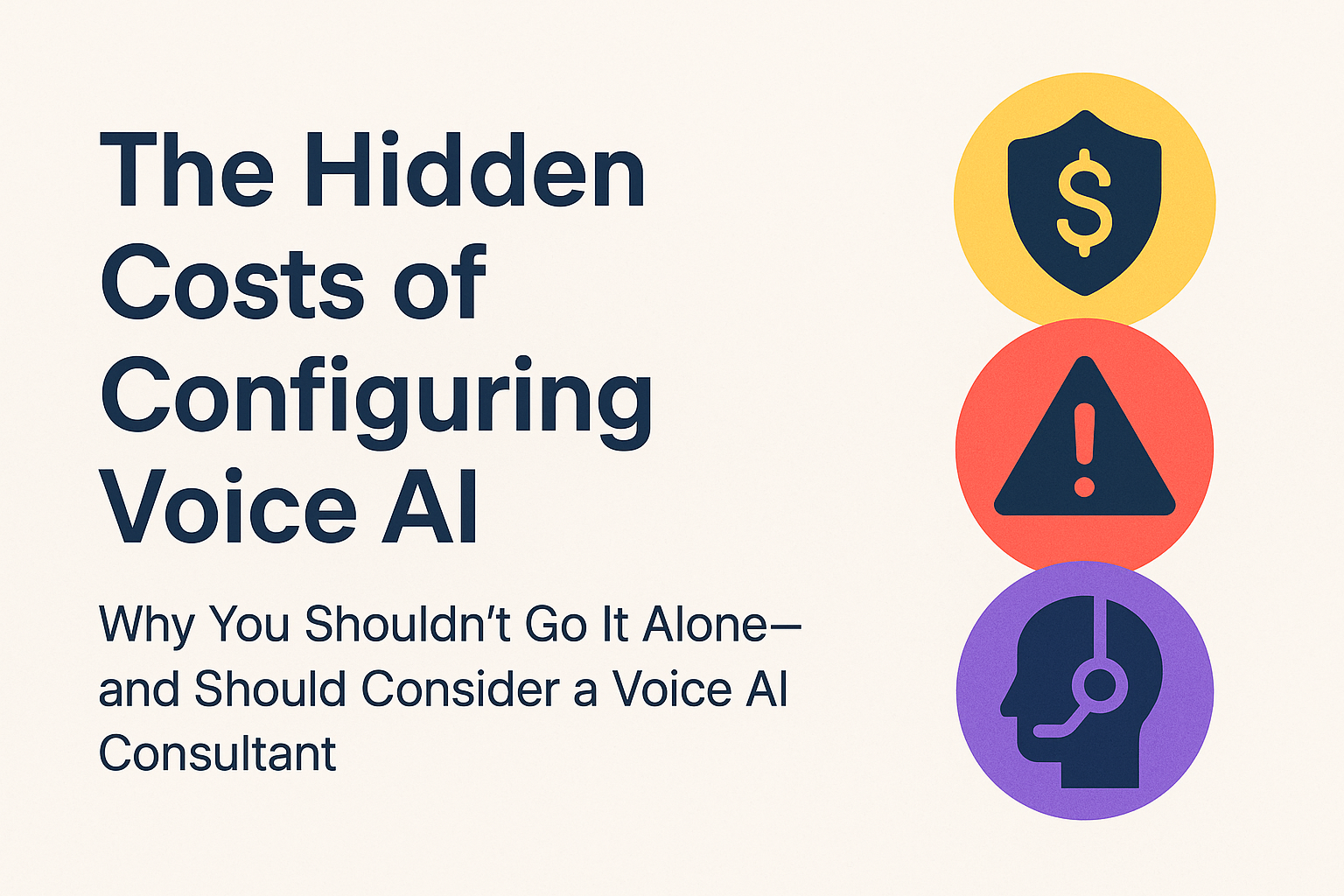
Why You Shouldn’t Go It Alone—and Should Consider a Voice AI Consultant
Voice AI platforms have come a long way. Tools like Yellow.ai, Twilio, and Euphonia are doing a solid job of making it easier to build voice agents. You get visual builders, pre-built flows, and LLM integrations—all wrapped up in a sleek interface that promises to handle customer calls, book appointments, or route support tickets.
But here’s the catch: easier isn’t easy.
Too many businesses think that once they’ve selected a platform, the hard work is over. The reality? The real costs: time, quality, reputation—begin after you sign the contract. Configuration, deployment, tuning, and ongoing optimization are where most Voice AI projects go sideways.
Let’s break down why even the best platforms still need expert setup—and why hiring a consultant could save you from expensive missteps.
The False Sense of “No-Code” Simplicity
Modern Voice AI platforms are loaded with “low-code” and “no-code” builders. It’s tempting to think you can drag, drop, and go live by the end of the week.
But those tools are just scaffolding. What they don’t do is:
- Design natural conversation flows
- Decide what gets escalated vs. resolved
- Handle interruptions, silences, or ambiguous requests
- Translate your business logic into seamless voice UX
Without that layer of strategy and experience, your AI sounds either too rigid or too random—and your customers notice.
Hidden Cost #1: Misaligned Expectations
Most companies treat voice AI like a simple software project. Buy a platform, hook it up, set a few rules, and you’re done.
In truth, it’s more like onboarding a new employee—one who happens to talk to every customer. It needs training, scripts, edge case handling, and performance reviews.
When internal teams try to wing it, they end up with:
- Voice agents that can’t handle basic questions
- Routing errors that cost real sales or service moments
- Calls that leave users frustrated, confused, or hanging up
You can build it. But if it’s not good? You’ll still be the one answering the phone.
Hidden Cost #2: Conversation Design Failures
Here’s something that catches most teams off guard: voice is not just a UI—it’s a UX.
What works in chat doesn’t always translate to voice. Timing matters. Tone matters. Giving users room to interrupt, rephrase, or go off-script matters. You need to design for:
- Interruption handling
- Intent misfires
- Failover and escalation
- Pacing, confirmation, and re-engagement
Get these wrong, and your voice agent starts sounding like a robot that doesn’t understand people. A consultant fluent in voice UX can avoid these pitfalls—and make your agent feel more human, not less.
Hidden Cost #3: Integration Complexity
Even the most well-spoken AI agent is only as good as what it connects to.
You need real-time access to:
- CRM records
- Scheduling tools
- Support ticketing systems
- Product or inventory databases
- API endpoints and webhook orchestration
DIY integrations often result in fragile systems that don’t scale—and that break quietly until someone complains. A consultant ensures these pipelines are robust, secure, and maintainable.
Hidden Cost #4: Tuning and Maintenance
Voice AI is not fire-and-forget. You don’t just “go live” and walk away.
Instead, you need:
- Regular call log reviews
- Prompt tuning
- Intent accuracy checks
- Voice model updates
- Escalation logic refreshes
These are not nice-to-haves. They’re what keep your AI from degrading over time. A consultant brings structured QA processes and continuous improvement workflows—so the voice agent gets better, not stale.
Hidden Cost #5: Lost Time and Burned Out Teams
Many internal teams spend weeks—or months—trying to configure their agent. What starts as a small project quickly turns into a team-wide distraction.
Meanwhile:
- Your devs aren’t working on your core product
- Your ops team is stuck debugging call flows
- Your customers are getting sub-par service
Hiring a consultant might feel like a luxury, but compared to losing months of productivity and goodwill? It’s a bargain.
What a Voice AI Consultant Actually Does
A good Voice AI consultant does more than set up call flows. They bring:
- Experience across platforms and industries
- Conversational UX skills tailored to voice, not just chat
- System integration expertise that ties your backend into your front line
- Analytics and monitoring tools to catch problems before they escalate
- Scalable playbooks for expansion, multilingual support, and new use cases
They turn your Voice AI from “it kind of works” to “this is a real asset to the business.”
When to Bring One In
- You’re launching your first voice agent
- You’ve had a rocky pilot or poor customer feedback
- You want to scale to more use cases or languages
- Your internal team lacks voice UX or telephony expertise
- You’re stuck but don’t know why
Spoiler: “after it breaks” is the most expensive time to bring in help.
Final Thoughts
Even the best Voice AI platforms don’t configure themselves. Behind every smooth customer conversation is a team that sweated the details—or a consultant who already knew them.
If you want voice AI to work, to scale, and to delight—don’t go it alone. The hidden costs of DIY aren’t just technical. They’re reputational. And in customer experience, that’s a price you don’t want to pay.
#agentic voice #AI #AI Voice #conversational al #LLM #Voice AI